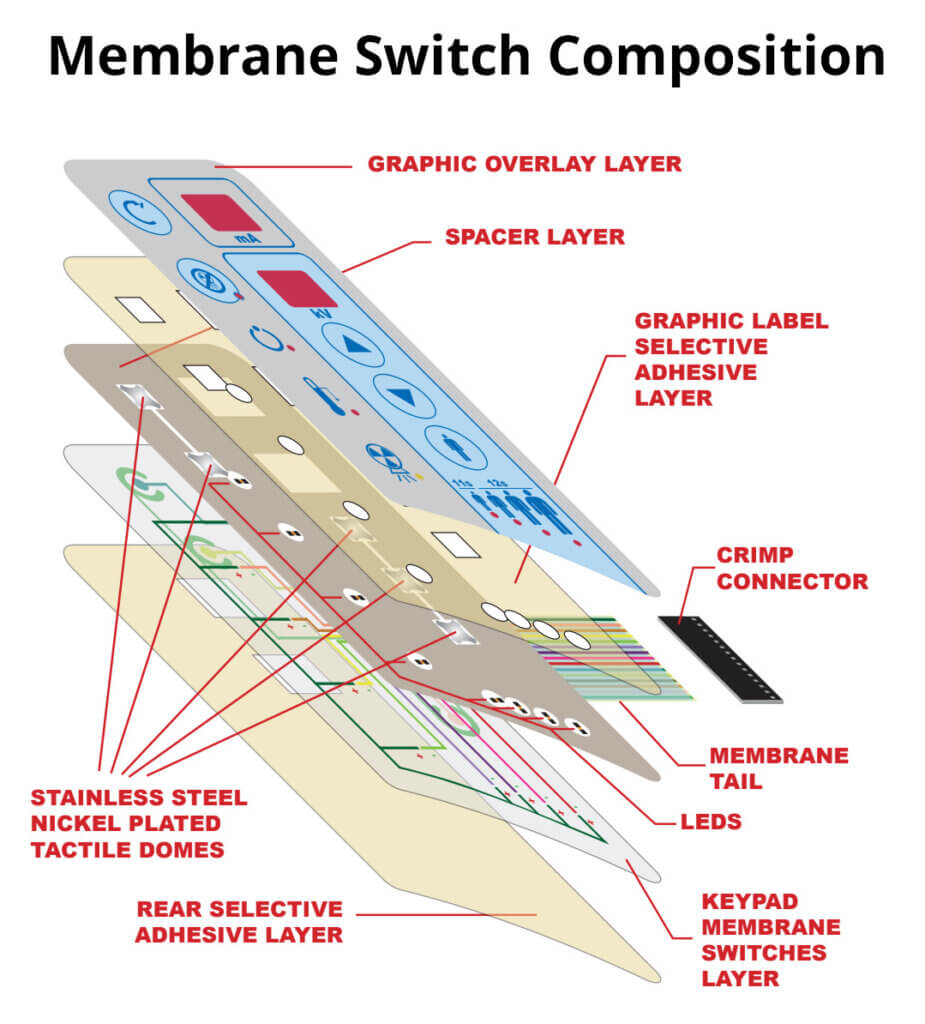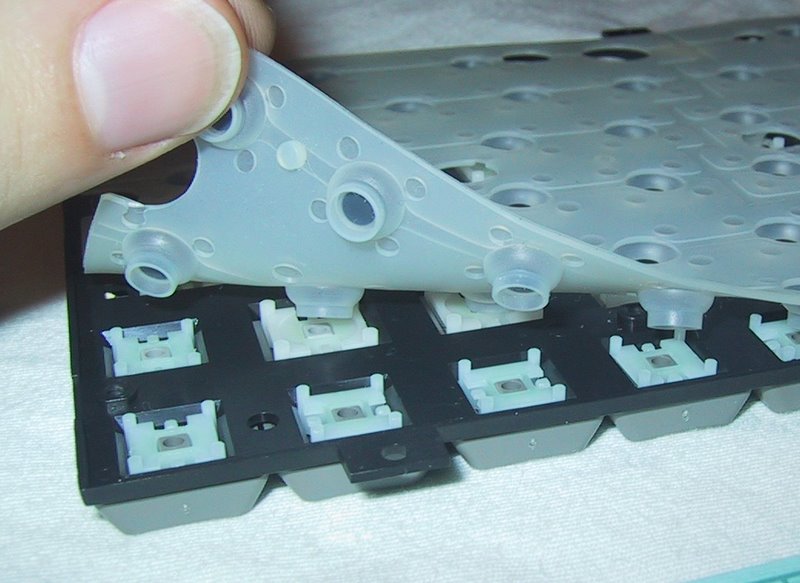Global Membrane Switch Manufacturer with Flexible Production Options
Global Membrane Switch Manufacturer with Flexible Production Options
Blog Article
Discovering the Manufacturing Refine of Membrane Switch for Numerous Industries
The production process of Membrane switches is a complicated venture that demands precision and attention to detail. From choosing ideal products to carrying out extensive high quality control actions, each action plays an essential role in making certain capability. Various sectors, consisting of auto and clinical, depend on these parts for their unique applications. Comprehending the details of this procedure reveals considerable understandings into how these switches are created and their effect across diverse industries.
Understanding Membrane Changes: A Review

Key Materials Used in Membrane Switch Production
In Membrane button production, the selection of crucial materials considerably affects performance and sturdiness. Conductive products, adhesives, and layers play crucial duties, while substrate selection impacts total performance and dependability. Comprehending these parts is crucial for enhancing the style and manufacturing of Membrane switches.
Conductive Products Introduction
Conductive materials play an essential role in the capability of Membrane buttons, ensuring dependable electric connections within the gadget. Frequently used materials consist of silver, copper, and carbon-based inks, each offering distinctive benefits. Silver is favored for its high conductivity and longevity, making it optimal for applications calling for durable performance. Copper, while slightly less conductive than silver, is a cost-efficient alternative commonly made use of in published circuits. Carbon-based inks give a versatile option, suitable for applications where flexibility and lower costs are prioritized, although they have lower conductivity contrasted to steel choices. The option of conductive products straight influences the general integrity, life-span, and efficiency of the Membrane switch, making it an important consideration in the manufacturing procedure.
Adhesives and Coatings
Adhesives and coverings are vital elements in the manufacturing of Membrane buttons, giving vital bonding and safety homes. These materials guarantee that various layers of the button, consisting of graphic overlays and circuitry, stick firmly to each other, enhancing resilience and functionality. Generally utilized adhesives include pressure-sensitive adhesives (PSAs) and epoxy-based formulations, which supply strong adhesion and strength. Coatings, such as polyurethane or acrylic, offer to safeguard versus ecological variables, consisting of wetness, abrasion, and chemicals. Additionally, coatings can boost tactile responses and visual appeal, adding to the overall customer experience. The choice of appropriate adhesives and layers is important for optimizing efficiency and longevity in varied applications across numerous industries, making certain that Membrane switches over satisfy details operational demands.
Substrate Choice Factors
Substratum option plays a crucial function in the manufacturing of Membrane switches, as it significantly affects their overall efficiency and resilience. Trick materials such as polyester, polycarbonate, and versatile printed circuit card (FPCBs) are generally used for their distinctive buildings. Polyester is preferred for its cost-effectiveness and resistance to abrasion, making it suitable for applications with high wear. Polycarbonate deals remarkable clarity and influence resistance, suitable for settings needing high visibility. FPCBs supply enhanced adaptability and are frequently made use of in intricate designs. The option of substrate likewise affects elements like thermal security, chemical resistance, and convenience of printing. Ultimately, choosing the proper substratum is vital for ensuring the performance and long life of Membrane switches across different markets.
The Design Process of Membrane Switches
The style procedure of Membrane buttons is a crucial phase that considerably influences the performance and visual appeals of the end product - membrane switch manufacturer. It begins with defining the certain needs of the application, consisting of dimensions, button layout, and tactile feedback preferences. Designers need to take into consideration user interaction, making certain that the button is instinctive and accessible.Next, products are picked based upon toughness, adaptability, and ecological resistance. The assimilation of graphics and branding components is also crucial, as it boosts visual appeal and communication. Prototyping permits iterative testing, allowing modifications based upon customer responses and efficiency evaluations.Additionally, the layout must account for the electrical parts, such as circuits and adapters, making sure dependability and convenience of usage. Inevitably, an effective layout integrates capability, appearances, and customer experience, leading the way for efficient production and resilient efficiency in numerous markets
Printing Methods for Membrane Switches Over
The printing methods made use of in Membrane switch manufacturing play an important role in identifying the end product's top quality and capability. Display printing uses advantages such as toughness and vivid shade application, while digital printing developments provide flexibility and accuracy in layout. Understanding these techniques can significantly influence the overall efficiency of Membrane buttons in numerous applications.
Screen Printing Benefits
Countless benefits make screen publishing a preferred strategy for creating Membrane switches. This technique permits for high-quality, in-depth layouts and lively shades, which are important for interface applications. Screen printing is especially reliable for using thick ink layers, enhancing sturdiness and responsive responses. Additionally, it uses exceptional bond to numerous substrates, guaranteeing long life sought after atmospheres. The process is economical for huge manufacturing runs, as it decreases setup time and waste. Display printing supports a broad array of inks, consisting of specialized and UV-curable alternatives, enabling flexibility in style. Its capacity to produce constant outcomes across multiple systems makes it a reliable option for makers going for high quality and efficiency in Membrane button production.
Digital Printing Innovations

Developments in digital printing innovation are transforming the manufacturing of Membrane switches, supplying suppliers cutting-edge remedies that boost layout flexibility and effectiveness. Digital printing permits complex styles and high-resolution graphics, allowing customized branding and functionality without the limitations of traditional approaches. This strategy minimizes configuration times and costs, facilitating much shorter manufacturing runs and very little waste, making it optimal for companies with varying needs. Furthermore, developments in ink formulations provide far better toughness and bond, ensuring long life in different atmospheres. As industries progressively look for customized and intricate designs, electronic printing sticks out as a vital technique, establishing a new standard in Membrane switch production. The combination of these innovations placements use this link producers to satisfy advancing market requires effectively.
Assembly and Layering of Membrane Switch Elements
Careful assembly and layering of Membrane button components are necessary to ensuring capability and sturdiness. This procedure begins with the specific alignment of numerous layers, consisting of the graphic overlay, adhesive, circuit layer, and backing material. Each part should be meticulously positioned to preserve electric integrity and interface responsiveness.During setting up, conductive traces are related to the circuit layer, usually made from products like polyester or polycarbonate. This layer is crucial, as it transfers signals when stress is applied. The sticky utilized for bonding these layers is additionally chosen for its capability to sustain ecological tensions while maintaining a safe and secure bond.Heat and stress are often applied during the assembly process to identify that the layers stick appropriately without jeopardizing the capability of the button. Finally, attention is offered to the edge securing to shield against moisture and pollutants, protecting the durability of the Membrane switch in numerous commercial applications.
Top Quality Control Procedures in Membrane Switch Manufacturing
Quality assurance actions play a necessary role in making certain the reliability and efficiency of Membrane switches following the setting up and layering of their components. In the manufacturing process, several key evaluations are conducted to copyright high quality requirements. These consist of aesthetic assessments for problems in printing and adhesive application, as well as next page useful examinations to verify the responsiveness of each switch.Additionally, environmental screening is executed to examine the switches' longevity against temperature level variations and humidity exposure. Suppliers usually implement analytical procedure control (copyright) techniques to keep an eye on production uniformity, enabling early discovery of anomalies.Furthermore, traceability systems are established to track elements and materials, making certain responsibility and helping with remembers if essential. Calibration of equipment and adherence to sector requirements are additionally essential to preserving product integrity. Jointly, these high quality control measures secure the performance of Membrane changes throughout numerous applications, ultimately boosting client satisfaction.
Applications of Membrane Switches Across Different Industries
Membrane switches are used throughout a diverse array of sectors, showcasing their versatility and adaptability. In the medical industry, they offer reputable and water-proof user interfaces for devices such as diagnostic tools and infusion pumps, making sure hygiene and ease of usage. The automobile market uses Membrane buttons for dashboard controls, making it possible for seamless interaction between the motorist and vehicle systems.In consumer electronics, these buttons are located in devices and handheld gadgets, using a streamlined, modern aesthetic while improving performance. Industrial applications additionally leverage Membrane switches for machinery control panels, where toughness and resistance to rough conditions are essential.Furthermore, the aerospace and defense industries make use of Membrane switches for cockpit instrumentation and communication systems, prioritizing reliability and performance under severe conditions. On the whole, Membrane switches play a critical duty in improving the user experience and operational efficiency across various This Site domains.
Frequently Asked Questions
The length of time Does It Take to Manufacture a Membrane Switch?
The manufacturing time for a membrane button typically ranges from a couple of days to numerous weeks - membrane switch manufacturer. Variables affecting this period include layout complexity, product accessibility, and production volume, all impacting the overall timeline considerably
What Is the Typical Lifespan of a Membrane Layer Switch?
The normal life expectancy of a membrane layer button typically varies from 1 to 5 million actuations, depending upon aspects such as worldly quality, environmental problems, and use regularity, significantly impacting toughness and general efficiency.
Can Membrane Switches Be Customized for Particular Applications?
Membrane buttons can indeed be personalized for certain applications. Their layout versatility enables alterations in size, form, colors, and graphics, making sure compatibility with special needs across various markets and improving capability and user experience.

Are Membrane Switches Over Ecologically Pleasant?
The environmental influence of Membrane switches over varies. Some materials made use of may not be eco-friendly, while improvements in making processes are increasingly focusing on sustainability, aiming to minimize waste and advertise recyclable parts in their manufacturing.
What Are the Common Failure Modes of Membrane Switches?
Common failure modes of Membrane buttons consist of delamination, sticky failure, deterioration from usage, moisture access, and electric failures. These concerns can substantially affect performance, efficiency, and lifespan in numerous applications across various sectors. Membrane buttons can be personalized to fit details style demands, such as shape, size, and functionality, making them highly adaptable.The construction generally involves numerous layers, consisting of a graphic overlay, adhesive, and a circuit layer, which work with each other to produce a seamless user experience. In Membrane button manufacturing, the choice of essential products substantially affects performance and sturdiness. The automobile industry uses Membrane buttons for control panel controls, enabling seamless communication in between the chauffeur and vehicle systems.In customer electronics, these switches are located in home appliances and portable gadgets, providing a streamlined, modern aesthetic while enhancing performance. Industrial applications likewise utilize Membrane changes for machinery control panels, where longevity and resistance to extreme conditions are essential.Furthermore, the aerospace and protection industries make use of Membrane buttons for cockpit instrumentation and interaction systems, focusing on dependability and performance under severe conditions. Membrane switches can undoubtedly be personalized for details applications.
Report this page